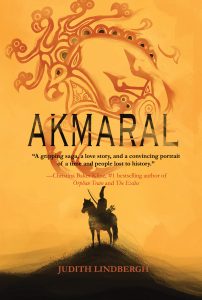A Q & A with Historical Novelist Judith Lindbergh
When I saw the book teaser for Judith Lindbergh’s newest novel, I was hooked:
A nomad woman warrior of the Central Asian steppes must make peace with making war. Akmaral is a foray into the ancient past, inspired by Greek myths of Amazon women warriors and archaeology that proves that they were real.
Judith is not a newcomer to writing fiction about women in the distant past. Her debut novel, The Thrall’s Tale, about women in the first Viking Age settlement in Greenland, was an IndieBound Pick, a Borders Original Voices Selection, and praised by Pulitzer Prize winners Geraldine Brooks and Robert Olen Butler. She received a 2024 Fellowship from the New Jersey State Council on the Arts. Judith is the Founder/Director of The Writers Circle, a creative writing center based in New Jersey. She contributed to the Smithsonian Institution’s exhibition Vikings: The Norse Atlantic Saga and provided expert commentary on two documentary series for the History Channel, including MANKIND: The Story of All of Us. (Which gave us a “wow, small world!” moment since I wrote the companion book for the series.)
Akmaral is coming out May 7 (today!) I’m delighted to have her here on the Margins to talk about the book and how she wrote it.
What inspired you to write a story about a nomadic woman warrior of the ancient Asian steppes?
The inspiration for Akmaral began with a PBS documentary about the amazing Siberian Ice Maiden. She was discovered in the Altai Mountains of Central Asia, a stunning landscape of high, lonely mountain pastures, which is probably why she laid virtually untouched in the permafrost for over 2400 years. Her body was so well-preserved that even her skin was intact, covered with ornate tattoos. Most were stylized wild animals, including a “flying deer” on her shoulder—an iconic symbol that now graces the cover of my book. Archaeologists also found a bronze mirror in her grave. For these ancient people, mirrors weren’t objects of vanity. They seem to indicate an important spiritual leader, perhaps even a shamaness.
Using DNA testing, they discovered that the Ice Maiden was actually European, despite being buried thousands of miles away. This intriguing breadcrumb provided a direct, biological connection to the Amazons of ancient Greece. The historian Herodotus tells that, after their defeat in the Trojan War, the Amazons joined with a group of Scythian warriors and eventually formed a new tribe, the Sauromatae. That’s how the Amazons became my characters’ ancestors.
But I wasn’t finished following the research’s trail. Akmaral truly took form when I learned about the “Issyk Gold Man” discovered in Kazakhstan in the 1960s. Along with thousands of gold, arrowhead-shaped ornaments, this body was buried with weaponry, so archaeologists assumed that it was male. But more recent scholars believe that the warrior may have been female. This possibility set my imagination on fire. Soon I discovered more hard evidence of women warriors all across the steppes. As I put together each remarkable discovery and countless other artifacts, Akmaral—a woman warrior and destined leader of her people—took shape in my mind.
What kinds of sources did you rely on to create rich fictional characters from a largely undocumented period of history?
Akmaral’s group, the Sauromatae, are part of a larger nomadic culture, the Scythians, who lived on the steppes from modern day Ukraine all the way to Mongolia and southern Siberia. The Scythians left no written record, so we only know about them through what others wrote down. Most of what we know comes to us from Herodotus who is often called the world’s first historian. But some scholars question how much of what he wrote was fact and how much was hearsay, skewed by the Greek perspective that Amazons were salacious and aberrant, warnings to Greek women who were expected to stay home and care for the children.
With so little, possibly unreliable documentary evidence, I didn’t have much to work with. But my inspiration hadn’t started with Herodotus. I knew that archaeology would help me find a story in the bones.
I combed through countless archaeological reports on kurgan (mound) burials from the Scythian period from around 800 – 300 BCE. I visited museums and perused exhibition catalogues when I couldn’t see the artifacts in person. I toured the virtual galleries of The Hermitage’s extraordinary collection of Scythian and Altai Bronze and Iron Age materials. And I used Google Earth to zoom down on ground level. (At the time, my children were young and I couldn’t leave them to travel to Central Asia myself.)
Beyond artifacts and landscape, I turned to modern descendants of these Iron Age nomad tribes for my characters’ daily life. People still practice traditional horse herding in Mongolia and Kazakhstan. And they celebrate archery, wrestling, and eagle hunting in their annual nomad games—a sort of Olympics for Central Asian traditional culture. Hunting and horse-back archery can be traced all the way back to prehistoric times through petroglyphs scattered around the region.
Finally, to give Akmaral authentic spiritual roots, I turned to the Bronze Age deer stones, mysterious vertical pillars carved with the same “flying deer” shapes as the Siberian Ice Maiden’s iconic tattoo. And I borrowed traditions from shamanism—a traditional healing practice connected to ancestor workshop that are still practiced by modern people in these regions today.
How do you walk the line between historical fact and fiction in your novels?
I work very hard to respect the research and not speculate beyond what seems reflected in the stones and bones. But relying on archaeology doesn’t provide many historical events to anchor my plot. I leaned on Herodotus’s tale of the Sauromatae’s origins to construct a backstory for Akmaral’s people. Also useful was the requirement that an Amazon warrior must kill in battle before she could bear a child. That one thought anchored the plot for the first act of my novel, where my characters must cope with this heavy responsibility.
I also wanted to honor the evidence of the burials that inspired Akmaral. I knew that the Ice Maiden had died young; she was only around thirty. And yet she was buried with six horses—a huge sacrifice—and countless other valuable grave goods. This shows that her death was a great loss and that she was very important to her people. Beyond that, I had no idea what she went through. Here’s where fiction comes in, as I use these archaeological anchors to tie together the artifacts and research until they begin to form characters and a story in my mind.
While this particular interpretation of the archaeology is clearly my own, the creativity comes in how I bring it to life. Akmaral is neither the Siberian Ice Maiden nor the Issyk Gold Man nor any of the other burials I studied. She is her own person with struggles that are unique to the circumstances and relationships I invented for her. The facts create the backdrop of culture, contacts, landscape, and belief, but the story is all her own.
What was most exciting about researching women in this period in history?
What I loved about writing Akmaral was the opportunity to consider a world where women were implicit equals. How would a world like that work? And what would be the consequences of that unique standing?
Since the beginning of recorded history and in countless cultures, women have rarely had agency over their own lives. Except for a few outliers—extraordinary women who broke barriers and defied social norms to achieve greatness or notoriety.
But Akmaral presented me with a unique opportunity to focus on a time and place when women were not marginalized. It is clear from the archaeology that these women were trained in military skills. Their thighbones are bowed from lifetimes spent on horseback and their finger bones are contorted from drawing their bows. Many died of battle wounds and were buried with their weaponry. This is undeniable, physical evidence that these warrior women existed. They were not fantasy heroines. And they weren’t anomalies. There are simply too many burials to claim that. That is what makes Akmaral’s setting and story remarkable.
What work of women’s history (fictional or non-fiction) have you read lately that you loved? Or for that matter, what work of women’s history have you loved in any format?
I’m thinking first of general nonfiction for readers of Akmaral who might want to dig deeper. I adored Adrienne Mayor’s The Amazons, which is an in-depth study of evidence of women warriors in the ancient world and beyond. Another great book is The Silk Roads by Peter Frankopan which dives into the complex history of the trade routes that have crossed from Europe to Asia for millennia.
As far as fiction, my favorite historical novels of late are Hamnet by Maggie O’Farrell and Hester by Laurie Lico Albanese. Both take the point of view of a woman in the shadow of an important male figure in history and elegantly tell the other side—how women are needed, perhaps loved, but often under-appreciated, neglected, or cast aside—and how the women find their own strength to survive.
***
Interested in learning more about Judith Lindbergh and her work?
Visit her website: https://judithlindbergh.com
Follow her on Instagram: https://www.instagram.com/judithlindbergh/
Follow her on Facebook: https://www.facebook.com/JudithLindberghAuthor
BUY AKMARAL at https://books2read.com/Akmaral







Thank you for this wonderful conversation, Pamela!
It was a delight!